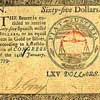Colonial and Continental Currency: A New Nation’s Currency
The Colonial economy depended largely on foreign coins, barter, and commodity money. In 1690, the Massachusetts Bay Colony issued the first Colonial currency. Other colonies soon began to issue their own paper currency. Usually denominated in Spanish Milled Dollars, Colonial notes were also denominated in British shillings, pounds, and pence. In 1764, the British declared Colonial currency illegal.
Beginning in 1775, the Continental Congress issued currency to finance the Revolutionary War. These notes, called Continentals, had no backing in gold or silver.
Continentals were backed by the “anticipation” of tax revenues. Easily counterfeited and without solid backing, the notes quickly became devalued, giving rise to the phrase “not worth a Continental.” This brief period marked the first time that U.S. currency’s value was derived solely from its purchasing power, as it is today.






















